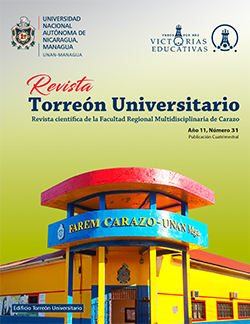Nicaragua's historical relations with the United States and its involvement in the national context (1937-1963)
DOI:
https://doi.org/10.5377/rtu.v11i31.14278Keywords:
International relations, cold war, foreign policy, subaltern sectorsAbstract
The purpose of this article is to analyze the diplomatic, historical, political-economic functions between the U.S. and Nicaraguan governments, particularly during the period known as the Somoza military dictatorship (1937-1963), offering a deep analytical vision of the events with the greatest impact on the national society. The method used in this research is deductive and inductive, analysis-synthesis through the reading, filing, and analysis of various academic sources located in digital repositories such as Scielo, Dialnet, and La Referencia, as well as physical spaces such as the Salomón de la Selva Central Library and the Center for the Diffusion of the Humanities (CDIHUM). The technique used in this text is the documentary review, which allowed the collection of information to state the concepts that support the study of the phenomena referred to the subject. In a conclusion we have that the implementation of foreign policies by the U.S. government in Nicaragua gave a result: first, separatist liberal-conservative groups as well as anti-imperialist sympathizers, both armed groups to fight against the prevailing system. Also, during this period different measures were taken to strengthen this relationship, and, secondly, the installation of U.S. companies in the territory in favor of their interests resulted in the exploitation of the underprivileged classes. All this would have been a plan orchestrated by the U.S. to neutralize communism in its eagerness to expand into the world in the context of the Cold War.
Downloads
References
Barbosa, F. (2007). Síntesis de la Historia Militar de Nicaragua: de las guerras intertribales precolombinas al Ejército de Nicaragua (1a. Edición). Centro de Historia Militar-Ejército de Nicaragua. https://www.ejercito.mil.ni/contenido/ejercito/historia/docs/historia_militar.pdf
Cardenal, A., & Martí, S. (1998). América Central: las democracias Inciertas. Universidad Autónoma de Barcelona: Tecnos.
Centeno, M. (2014). Somoza en Paraguay: vida y muerte de un dictador. Asunción: CIMDE
Débray, R (1970). La revolución dentro de la revolución. Casa de las Américas.
Ferrero, M. (2009). Violencia y represión en el ocaso de los Somoza: las condiciones carcelarias de los presos políticos. Historia Crítica (39), 154-178 http://www.scielo.org.co/pdf/rhc/n39/n39a10.pdf
Ferrero, M. (2010). Luis “el bueno”. El gran desconocido de la dinastía de los Somoza. Historia Contemporánea, (22), 305-334. https://www.researchgate.net/publication/286161502_Luis_el_bueno_el_gran_desconocido_de_la_dinastIa_de_los_Somoza/fulltext/5666889e08ae15e74634d162/Luis-el-bueno-el-gran-desconocido-de-la-dinastIa-de-los-Somoza.pdf
Ferrero, M. (2012). Las Relaciones Interdependientes de Los Somoza de Nicaragua Con EE. UU (1936-1979). Revista de Historia Contemporánea, (10), 1-48. http://hispanianova.rediris.es/10/articulos/10a003.pdf
González, R. (2009). Nicaragua. Dictadura y revolución. Revista Digital de Historia y Arqueología desde el Caribe, 6 (10), 231-264. https://dialnet.unirioja.es/servlet/articulo?codigo=3013321
Puig, S. (2002). La izquierda revolucionaria en Centroamérica: El FSLN desde su fundación a la insurrección popular. Universitat Autónoma de Barcelona (203).
Pinto, J., & Nascimento, G. (2012). La política del "Buen Vecino" y la influencia cultural de Estados Unidos en América Latina. Horizonte Histórico - Revista Semestral De Los Estudiantes De La Licenciatura En Historia De La UAA, (6), 62–70. https://revistas.uaa.mx/index.php/horizontehistorico/article/view/1211
Prozapas, A. (2018) Los dos caballeros de la Política de la Buena Vecindad: Franklin Delano Roosevelt, Orson Welles y la construcción de la imagen de América Latina. [tesis de licenciatura, Universidad Nacional de la Plata: FAHCE] http://www.memoria.fahce.unlp.edu.ar/tesis/te.1625/te.1625.pdf
Romero, G. (1987). Apuntes de Historia de Nicaragua (Vol. I). Universidad Autónoma de Nicaragua: Departamento de Ciencias Sociales.
Romero, J et al. (2002). Historia de Nicaragua, Texto básico. UNAN-Managua: Editorial de Ciencias Sociales
Rouquié, A. (1984). El estado militar en América Latina. Emece
Walter, K. (2004). El régimen de Anastasio Somoza 1936-1979. IHNCA-UCA
Zimmerman, M. (2012) Carlos Fonseca y la Revolución Nicaragüense (2ª. Edición). Editora Expressao Popular.
Published
How to Cite
Issue
Section
License
Copyright (c) 2022 National Autonomous University of Nicaragua, Managua.

This work is licensed under a Creative Commons Attribution-NonCommercial-NoDerivatives 4.0 International License.
The authors who publish in this journal agree to the following terms.
- The author or authors of the articles, essays or research grant the National Autonomous University of Nicaragua, Managua (UNAN-Managua) the editing rights (copyright) of the submitted work, therefore the University has the exclusive right to publish the article for the entire copyright period.
- These copyrights/authors authorize Torreón Universitario Magazine and the University to edit and disseminate/publish the article in said Magazine, including printed and electronic reproduction, storage, retrieval and any other type of publication, and sources of secondary information as services. of summaries and databases, they also empower it to protect the article against unauthorized use for dissemination by printed or electronic media (PDF, HTML, EPUB, XML or others).
License for use of content
The magazine uses the Creative Commons Attribution-NonCommercial-NoDerivs 4.0 International License.
Under this statement:

This journal is licensed under a Creative Commons Attribution-NonCommercial-NoDerivatives 4.0 International License. It can be copied, distributed and transmitted publicly as long as the author and source are cited (Revista Torreón Universitario), it should not be modified or used for any commercial purpose. The full license can be found at http://creativecommons.org/licenses/by-nc-nd/4.0/.



